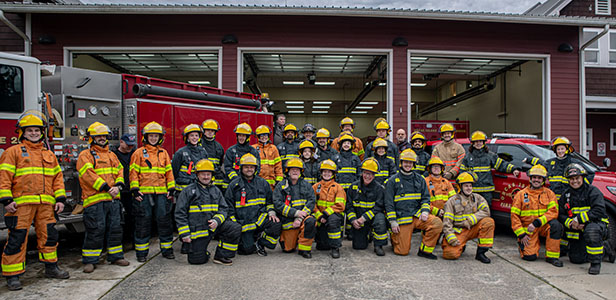On the agenda for the Feb. 8 Orcas meeting of the County Council was the establishment of a Commercial LAMIRD (Limited Area of More Intense Rural Development) at the Country Corner. The County Council heard County staff and Planning Commission recommendations, public comments and the Eastsound Planning Review Committee’s (EPRC’s) concerns about retaining the Sub-area plan as a guide for the growth and development of the Eastsound Village,and agreed to continue deliberations at their March 9 meeting.
County Senior Planner Colin Maycock presented the Planning Department’s Staff recommendations regarding the Country Corner LAMIRD, describing the “Country Corner Study Area” as “134 acres outside the UGA (Eastsound Urban Growth Area), subject to moratorium with urban levels of zoning, which is inconsistent with GMA (the Growth Management Act) and [County] comprensive plan’s understanding of rural areas.”
Maycock summarized the background for the current proposal to designate 6 lots of the study area as a commercial LAMIRD: in 2004, a county ordinance “put a moratorium in place in Eastsound while planning was still going on for the Eastsound UGA.”
In 2005, the UGA boundaries were redrawn to a more limited area, and the “Country Corner Study Area” was identified as 69 parcels, and 134 acres, (roughly from Mt. Baker Road to Ship Bay Inn, and from Bartell Road to the McKay property west of Crescent Beach Service gas station).
For the past year, the County Planning Department has held public meetings that narrowed the designation down to three options:
1) to retain existing zoning in the study area, extend the service park zoning, stop “split zoning” of service park parcels and extend the area to the south side of Crescent Beach Road – no commercial LAMIRD established
2) to allow for a 6-parcel 16 acre commercial LAMIRD
3) to create commercial zoning, retain the service zone and rezone residential areas within the study area to 2 housing units per acre. The Planning Department recommended this option, relying on logic from Growth Management Hearings Board decisions..
Maycock said that “a more recent question” has surfaced: “whether the Country Corner LAMIRD development regulations should be considered a subset of the [Eastsound] Sub-area plan, or be treated as other activity centers, and regulated by the UDC [Uniform Development Code].”
Maycock reviewed the Planning Commissions recommendations, which included :
1) Minimum lot size of 2 acres, with density of 1 unit per 2 acres,
2) Daycare centers classified as a discretionary use
3) Eating and drinking establishments changed from conditional use to disallowed use
4) Storage changed from discretionary to disallowed use
5) Agricultural uses changed from conditional to discretionary use
6) Transient rentals disallowed
In response to questions from Council Member Rich Peterson, Maycock said that the “Subarea vs. UDC” discussion is “largely an issue of the depth of regulation, 3 vs. 2 layers; also the number of times it can be regulated (3 times a year for the UDC vs. once a year)” for the Sub-area Plan.
Peterson had other questions about use of the area for personal wireless communication, and Council Member Howie Rosenfeld said that public input must be heard before the land use regulations regarding cell phone towers are changed.
Upon opening the public comment portion of the hearing, Bob Gamble, Chair of the Planning Commission, spoke to the meeting, stating that he was not speaking on behalf of the Commission. Their recommendation to ban eating and drinking establishments was based on the desire to avoid creating an “East Eastsound” and a “West Eastsound.” Rather, Gamble said, it was desired to concentrate eating and drinking establishments in the current “core” of Eastsound. “From a good planning perspective, you don’t want to create two separate towns,” Gamble said.
“Also, someday, Crescent Beach Road is going to wash out in a big storm, and we’ll have to decide whether to spend money to replace road or let nature take it course.”
Gamble said the decision on mini-storage was “problematic: the concern was nobody wanted to shut down what’s there, but there was concern about a ‘mini-storage farm’” being developed on the site.
Gulliver Rankin, Chair of the EPRC, said that the committed feels it is “still the best venue for reviewing permits,” within the Sub-area plan boundaries established in 1980.
“We feel that the current Sub-area plan boundaries are valid and should not be reconciled with UGA boundaries; it allows us to plan for a greater area if the UGA boundaries are extended.”
EPRC member Patty Miller stated that the Sub-area Plan was developed in the late 1970s as a “community, bottom-up plan, rather than acquiesce planning to the state…there is nothing in GMA that dictates we remove it from the Comp Plan. As a community, it gives us a broader area to plan for — we can’t decide that if you separate [the proposed LAMIRD from the Sub-area plan]”
Barbara Bentley asked that the issue of night time light pollution be addressed.
Chips Carpenter, the owner of the “barn storage” lot to the south of Crecent Beach Road (and one of the 6 lots subject to the proposed commercial LAMIRD regulations), objected to changing his lot’s use from discretionary to prohibited. “For no additional storage facilities to be built is unfair to us as a business that’s existed for 30 years; that should be provided for.
“Businesses need to have the ability to adapt to change. Please allow us sufficient flexibility to meet the changing needs of community. Only a few years ago the county approved establishment of more storage area at Country Corner: what valid reason is there for this sudden reversal of policy?
“We look to the County Council for a reversal [of the Planning Commission recommendation,” Carpenter said.
Rich Peterson suggested a conditional use designation would be appropriate, and Carpenter assured the Council that he would continue to enforce his property’s legitimate uses, as he has in the past.
Ed Sutton, current chair of the Eastosund Sewer and Water District Commission, spoke to reinforce the EPRC statement “that the work done by the community over a lengthy period of time in the Sub-area plan is extremely relevant.”
Sutton said that the ESWD had applied to the Department of Ecology for sewer service to be provided to the area, “consistent with Sub-area plan. We anticipated the sewer service district would be assigned to Sub-area.
“Our service area still includes that corner; [it] was established based on community work to establish the Eastsound Sub-area 30 years ago. We support the position of the EPRC.”
Maycock returned to address the issues brought up in the public comment portion.
He said that personal wireless facility use is listed in the county code; that all lighting must be recessed and not allowed glare or reflection beyond boundaries, and “light pollution is a code enforcement issue.”
Development was “expressly conceived under GMA to be limited,” Maycock said, and not allowed to expand beyond 1990 boundaries and uses.
“The county has clear regulations that sewer [service] is not allowable outside the UGA; our Comp Plan no longer has reference to any line outside the UGA.”
After some discussion amongst themselves, the Council decided to continue their deliberations on March 9.
**If you are reading theOrcasonian for free, thank your fellow islanders. If you would like to support theOrcasonian CLICK HERE to set your modestly-priced, voluntary subscription. Otherwise, no worries; we’re happy to share with you.**







